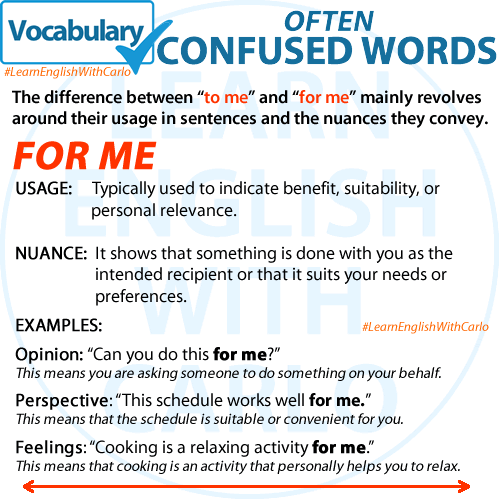The difference between “to me” and “for me” mainly revolves around their usage in sentences and the nuances they convey. Here’s a breakdown:

“To me”
- Usage: Generally used to express a personal opinion, perspective, or feeling.
- Nuance: It indicates that the statement is subjective and personal.
Examples:
- Opinion: “To me, this painting is beautiful.”
- This means that in your opinion, the painting is beautiful.
- Perspective: “It seems to me that he is very talented.”
- This means that from your point of view, he appears very talented.
- Feelings: “This song means a lot to me.”
- This means that the song has significant emotional value for you.

“For me”
- Usage: Typically used to indicate benefit, suitability, or personal relevance.
- Nuance: It shows that something is done with you as the intended recipient or that it suits your needs or preferences.
Examples:
- Benefit: “Can you do this for me?”
- This means you are asking someone to do something on your behalf.
- Suitability: “This schedule works well for me.”
- This means that the schedule is suitable or convenient for you.
- Personal relevance: “Cooking is a relaxing activity for me.”
- This means that cooking is an activity that personally helps you to relax.

Comparing the Two
- Subjective View (To Me):
- “To me, the movie was confusing.” (Your personal opinion about the movie’s clarity)
- Benefit/Convenience (For Me):
- “This book was written for me.” (The book is intended to benefit or be useful to you)
Combined Use
Sometimes, sentences can use both “to me” and “for me,” emphasizing different aspects:
- “To me, this solution seems ideal for me.”
- This means, in your opinion, the solution appears perfect and is also suitable for your needs.
Understanding the difference between “to me” and “for me” helps in conveying your thoughts more precisely and appropriately in various contexts.
